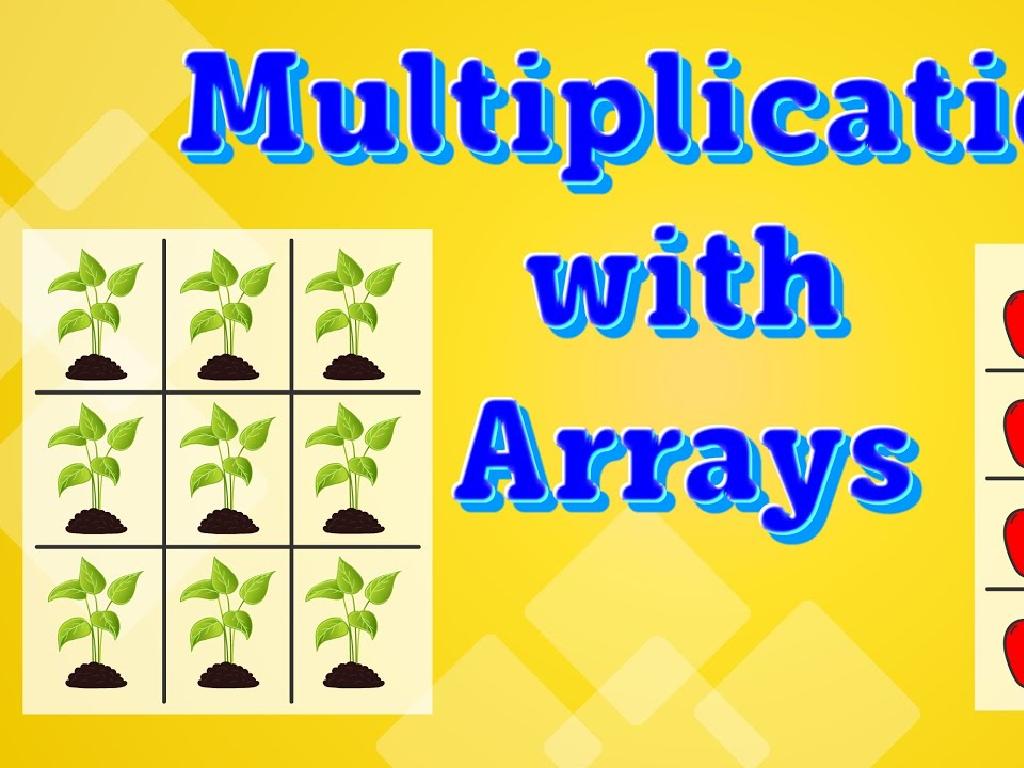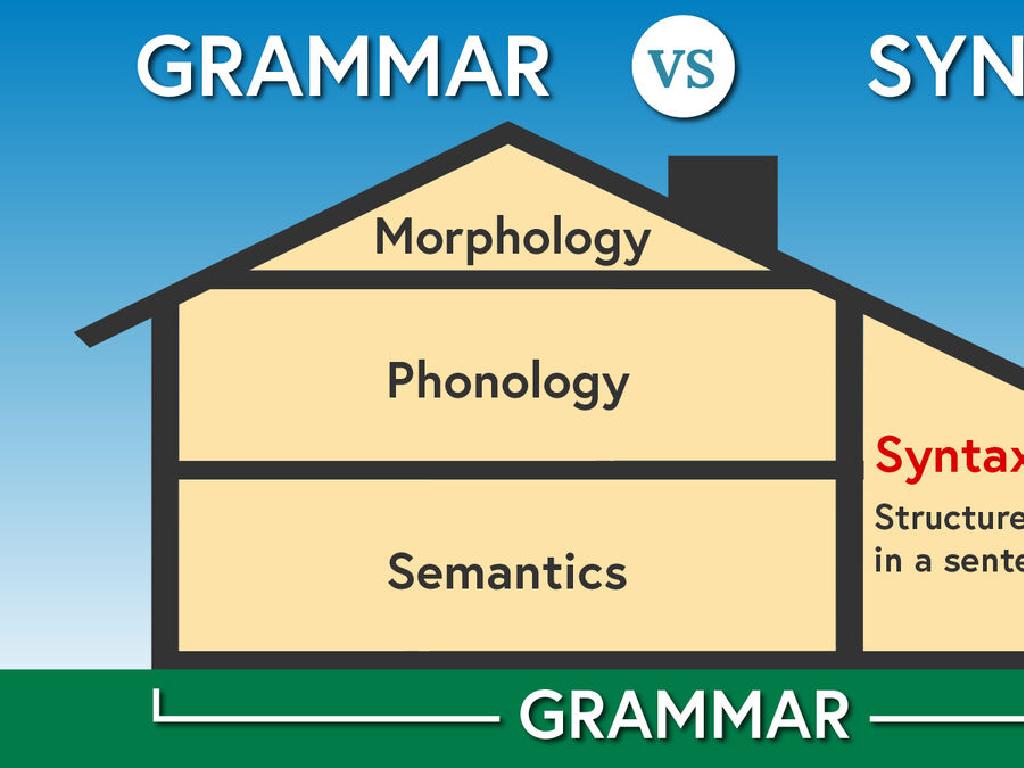Read And Construct Animal Life Cycle Diagrams
Subject: Science
Grade: Fifth grade
Topic: Animals
Please LOG IN to download the presentation. Access is available to registered users only.
View More Content
Welcome to Animal Life Cycles
– Explore the journey of life
– Define a Life Cycle
– A series of stages from birth to reproduction to death
– Importance of Life Cycle knowledge
– Helps predict animal behavior & survival strategies
– Impact on ecosystems
– Understanding roles in food webs & environmental balance
|
This slide introduces the concept of animal life cycles to fifth-grade students. Begin by discussing the journey of life, emphasizing that all living things go through a cycle from birth, growth, reproduction, to death. Define what a life cycle is and use examples like butterflies or frogs to illustrate the stages. Explain why it’s important to learn about life cycles, such as understanding how animals grow, survive, and reproduce. Highlight the significance of life cycles in maintaining ecosystem balance and the roles animals play in their habitats. Encourage students to think about how life cycles affect not just individual animals, but entire species and their environments.
Understanding Animal Life Cycles
– Define a Life Cycle
– Sequence of stages from birth, through reproduction, to death
– Explore Life Stages: Birth to Death
– Birth, growth, reproduction, and death are universal stages
– Each Animal’s Life Cycle is Unique
– Variations exist: butterflies have metamorphosis, frogs have tadpole stage
– Importance of Life Cycle Knowledge
|
This slide introduces the concept of a life cycle, which is the series of stages an organism goes through from the beginning of its life until its death. Emphasize that while all animals go through the stages of birth, growth, reproduction, and death, each species has a unique life cycle. Some animals, like butterflies, undergo dramatic transformations, while others have more direct development. Understanding life cycles is crucial for comprehending how different species survive and reproduce. Encourage students to think about the life cycles of animals they are familiar with and how these might differ from one another.
Life Cycle of a Butterfly
– Egg Stage: Start of Life
– Butterflies begin life as an egg, often laid on leaves.
– Caterpillar: Growth Phase
– Caterpillars hatch from eggs, eating leaves to grow.
– Pupa: Transition Stage
– In the pupa stage, caterpillars develop inside a chrysalis.
– Butterfly: Reproduction Cycle
– Adult butterflies emerge, mate, and lay eggs to continue the cycle.
|
This slide introduces students to the four stages of a butterfly’s life cycle. Begin with the egg stage, explaining how and where butterflies lay their eggs. Move on to the caterpillar stage, emphasizing the importance of this phase for growth and development. Discuss the pupa stage, where the caterpillar forms a chrysalis and undergoes metamorphosis. Conclude with the butterfly stage, where students learn about the adult butterfly’s role in reproduction. Encourage students to think about the changes that occur at each stage and how each stage is crucial for the butterfly’s development. Provide examples of local butterflies if possible, and consider bringing in a chrysalis for observation.
Life Cycle of a Frog
– Frog life begins as spawn
– Frogs lay clumps of eggs, called spawn, in water.
– Tadpoles: Baby frogs in water
– Tadpoles hatch from eggs, have gills and tails for aquatic life.
– Metamorphosis: Tadpole to frog
– Tadpoles grow legs, lose tails, and develop lungs to prepare for land.
– Adult Frog: The life cycle’s end
– Fully grown, ready to lay eggs and continue the cycle.
|
This slide introduces the life cycle of a frog, which is a classic example of metamorphosis in animals. Start by explaining that frog life begins with eggs laid in water. These eggs, known as spawn, hatch into tadpoles, which are entirely aquatic. As tadpoles mature, they undergo a process called metamorphosis, where they develop legs and lungs for life on land, and their tails recede. Once fully metamorphosed, they become adult frogs, capable of surviving on land and eventually reproducing to start the cycle anew. Encourage students to think about the changes the frog goes through and why each stage is crucial for its survival. This can be a great opportunity to discuss the importance of each life stage and how it contributes to the frog’s life cycle.
Comparing Animal Life Cycles
– Similarities in life cycles
– Many animals share stages like birth, growth, reproduction, and death.
– Unique life cycle traits
– Some animals metamorphose, others don’t. Lifespan varies widely.
– Compare insects, amphibians, mammals
– Insects (butterflies) metamorphose, amphibians (frogs) change form, mammals (humans) grow steadily.
– Understanding life cycle stages
|
This slide aims to teach students about the common stages in the life cycles of animals while also highlighting the unique aspects of different species. Students should understand that despite the differences in life cycles, all animals go through a series of changes from birth to adulthood. They should compare how an insect like a butterfly goes through metamorphosis, an amphibian like a frog undergoes drastic changes from tadpole to adult, and a mammal like a human develops gradually. Encourage students to think about the life cycles of animals they are familiar with and how they might be similar or different from the examples given.
Constructing Animal Life Cycle Diagrams
– Identify animal life stages
– Stages include birth, growth, reproduction, and death
– Organize stages circularly
– Place stages in a circle to represent the cycle
– Use arrows to show progression
– Arrows indicate the order of stages
– Example: Butterfly Life Cycle
– Egg, larva, pupa, and adult stages with arrows in between
|
This slide aims to teach students how to construct and understand life cycle diagrams of animals. Start by identifying the key stages in an animal’s life, which typically include birth, growth, reproduction, and death. Students should learn to arrange these stages in a circular format to emphasize the cyclical nature of life. Arrows are used to indicate the flow from one stage to the next. Use the butterfly as an example to illustrate these points, showing its life cycle from egg to larva (caterpillar), to pupa (chrysalis), and finally to adult butterfly. Encourage students to draw their own diagrams and to consider the life cycles of different animals they are familiar with.
Class Activity: Create Your Own Life Cycle
– Select an animal of interest
– Investigate its life cycle stages
– Look for information in books or credible online sources
– Illustrate and label the life cycle
– Use the provided template to draw each stage and add labels
– Share your life cycle diagram with the class
|
This activity is designed to help students understand the concept of life cycles by researching and creating one for a specific animal. Provide a variety of resources for students to choose from and guide them on how to find reliable information. Offer a template for the life cycle diagram to ensure consistency in the presentation. Encourage creativity in their illustrations while maintaining accuracy in the stages. Once completed, have each student present their life cycle diagram to the class, explaining each stage. This will reinforce their understanding and allow for peer learning. Possible animals for the activity could include a frog, butterfly, chicken, or even a plant for variety.
Sharing Our Animal Life Cycle Diagrams
– Present your life cycle diagram
– Discuss interesting findings
– Share unique stages or facts about your animal
– Engage in Q&A with classmates
– Ask questions about others’ diagrams
– Learn from each other’s discoveries
– Compare different animal life cycles
|
This slide is meant to facilitate a classroom activity where students will share the animal life cycle diagrams they have created. Each student should briefly present their diagram to the class, highlighting any part of the life cycle they found particularly interesting or unique. Encourage students to ask questions about their classmates’ diagrams to foster a collaborative learning environment. This activity will help students learn from each other and gain a deeper understanding of the diversity of life cycles in the animal kingdom. Provide guidance on how to give constructive feedback and encourage curiosity. Prepare to mediate the Q&A to ensure that every student gets a chance to participate and that the discussion remains on topic.
Review and Quiz Time: Animal Life Cycles
– Recap today’s key points
– Pop Quiz on life cycle stages
– Identify stages in diagrams of various animals
– Significance of life cycle stages
– Each stage has a role in growth & survival
– Discuss life cycle diversity
– Compare different animals’ life cycles
|
This slide is designed to consolidate the students’ knowledge on animal life cycles. Begin with a brief recap of the day’s lesson, highlighting the key points about the stages of life cycles in different animals. Follow this with a pop quiz, asking students to identify the stages of life cycles in diagrams of various animals. Discuss the importance of each stage, emphasizing how each contributes to the animal’s growth, development, and survival. Encourage students to think about how life cycles can vary greatly among animals, such as insects, amphibians, and mammals. This review session will help solidify their understanding and prepare them for the quiz, as well as future lessons on life cycles.
Conclusion & Homework: Animal Life Cycles
– Excellent job learning about life cycles!
– Homework: Craft an animal life cycle diagram
– Illustrate stages from birth to adulthood
– Choose an animal we haven’t studied
– Research an unfamiliar animal’s life stages
– Present your diagram in the next class
– Be prepared to explain your diagram to the class
|
Today’s class provided a foundation for understanding the life cycles of various animals. For homework, students are tasked with creating a detailed diagram of an animal’s life cycle that we did not cover in class. This will help reinforce their understanding of the concept and encourage independent research. Students should include all the key stages of the animal’s life cycle, from birth to maturity. In the next class, they will have the opportunity to share their work, which will foster public speaking skills and peer learning. Provide guidance on how to research and suggest they include both images and descriptions in their diagrams.






